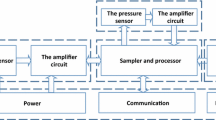Abstract
End tidal carbon dioxide measurements with an electro acoustic capnograph prototype have been demonstrated. The aim of this study was to verify that it is possible to obtain an adequate capnogram using the prototype and to investigate the influence of ambient temperature and humidity variations. By simultaneous measurements with a reference capnograph, on subjects performing exercise, hypo- and hyperventilation, PETCO2 readings from the reference were compared with the output signal from the prototype. The capnogram from the prototype correlated well with the reference in terms of breath time. The first parts of the expiration and inspiration phases were steeper for the reference than the prototype. The output signal from the prototype correlated well with the reference PETCO2 readings with a correlation coefficient of 0.93 at varied temperature and relative humidity.







Similar content being viewed by others
References
Campbell FA, McLeod ME, Bissonnette B et al (1994) End-tidal carbon dioxide measurement in infants and children during and after general anaesthesia. Can J Anaesth 41(2):107–110
Cheng EY, Stommel KA (1989) Quantitative evaluation of a combined pulse oximetry and end-tidal CO2 monitor. Biomed Instrum Technol 23(3):216–221
Folke M, Cernerud L, Ekström M et al (2003) Critical review of non-invasive respiratory monitoring in medical care. Med Biol Eng Comput 41:377–383
Folke M, Hök B, Ekström, M et al (2004) End Tidal Carbon Dioxide Measurement Using an Electro Acoustic Sensor. In: Proceedings of IEEE-EMBC, San Francisco, pp 362
Folke M, Gullstrand L, Hök B (2005) A pilot study to estimate the lactate threshold using an electro acoustic sensor. In: Proceedings of the 13th Nordic-Baltic conference on biomedical engineering & medical physics, Umeå pp 249–250
Folke M, Hök B. (2005) Temperature independence of an electro acoustic capnograph. In: Proceedings of the 13th Nordic-Baltic conference on biomedical engineering & medical physics, Umeå, pp 136–137
Gløersen PG, Hök B, Jensen GU et al (2005) Micro-acoustic sensors for CO2 tracking. Sensors + Test, Nuremberg, May 10–12
Granstedt F, Folke M, Bäcklund Y et al (2001) Gas sensor with electroacoustically coupled resonator. Sens Actuators B 78:161–165
Granstedt F, Hök B, Bjurman U et al (2001) New CO2 sensor with high resolution and fast response. In: Proceedings of IEEE-EMBC, Istanbul, pp 3100–3103
Granstedt F, Folke M, Ekström M et al (2005) Modelling of an electroacoustic gas sensor. Sens Actuators B 104:308–311
Hök B, Tallfors M, Sandberg G et al (1998) A new sensor for indoor air quality control. In: Proceedings of Eurosensors XII, Southampton, pp 1072–1075
Hök B, Tallfors M, Sandberg G et al (1999) Acoustic gas sensor with ppm resolution. In: Proceedings of Eurosensors XIII, Den Hague, pp 319–320
Hök B, Blückert A, Dalsrud V et al (2004) Scaling properties and MEMS implementation of acoustic gas sensors. MicroStructure Workshop, MSW, Ystad, pp 101–105
Kavanagh BP, Sandler AN, Turner KE et al (1992) Use of end-tidal PCO2 and Transcutaneous PCO2 as noninvasive measurement of arterial PCO2 in extubated patients recovering from general anerthesia. J Clin Monit 8:226–230
Lenz G, Heipertz W, Epple E (1991) Capnometry for continuous postoperative monitoring of nonintubated, spontaneously breathing patients. J Clin Monit 7:245–248
Lumb AB (2000) Nunn’s applied respiratory physiology. Butterworth-Heinemann, Woburn pp 461–471
van Randeraat J, Setterington RE (1974) Piezoelectric ceramics 2nd edn. Mullard, London pp 159–168
Rayleigh JWS (1898) The theory of sound 2nd edn, vol 2. Dover Books, New York 18ff
Santos LJ, Varon J, Pic-Aluas L et al (1994) Practical uses of end-tidal carbon dioxide monitoring in the emergency department. J Emerg Med 12(5):633–644
Solomon RJ (1981) A reliable, accurate CO2 analyser for medical use. Hewlett Packard J 32(9):2–21
Ward KR, Yealy DM (1998) End-tidal carbon dioxide monitoring in emergency medicine, part 1: basic principles. Acad Emerg Med 5(6):628–636
Ward KR, Yealy DM (1998) End-tidal carbon dioxide monitoring in emergency medicine, part 2: clinical applications. Acad Emerg Med 5(6):637–646
Author information
Authors and Affiliations
Corresponding author
Rights and permissions
About this article
Cite this article
Folke, M., Hök, B. A new capnograph based on an electro acoustic sensor. Med Bio Eng Comput 46, 55–59 (2008). https://doi.org/10.1007/s11517-007-0228-4
Received:
Accepted:
Published:
Issue Date:
DOI: https://doi.org/10.1007/s11517-007-0228-4




